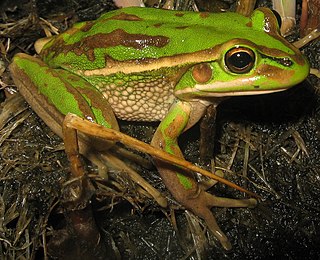
Ayahuasca is a South American entheogenic brew commonly made out of the Banisteriopsis caapi vine, the Psychotria viridis shrub or a substitute, and possibly other ingredients; although, in the West, a chemically similar preparation also known and sold as ayahuasca, but occasionally also known as "pharmahuasca", can be prepared using illicitly manufactured N,N-Dimethyltryptamine (DMT) and a pharmaceutical monoamine oxidase inhibitor (MAOI) such as isocarboxazid. The brew is used as a traditional spiritual medicine in ceremonies among the indigenous peoples of the Amazon basin.

N,N-Dimethyltryptamine is a chemical substance that occurs in many plants and animals and which is both a derivative and a structural analog of tryptamine. It can be consumed as a psychedelic drug and has historically been prepared by various cultures for ritual purposes as an entheogen. DMT is illegal in most countries.

5-MeO-DMT (5-methoxy-N,N-dimethyltryptamine) is a psychedelic of the tryptamine class. It is found in a wide variety of plant species, and at least one toad species, the Sonoran Desert toad. Like its close relatives DMT and bufotenin (5-HO-DMT), it has been used as an entheogen in South America. Slang terms include Five-methoxy, The power, and Toad venom.

Anadenanthera peregrina, also known as yopo, jopo, cohoba, parica or calcium tree, is a perennial tree of the genus Anadenanthera native to the Caribbean and South America. It grows up to 20 m (66 ft) tall, and has a horny bark. Its flowers are pale yellow to white and spherical. It is an entheogen which has been used in healing ceremonies and rituals for thousands of years in South America.

Genlisea is a genus of carnivorous plants also known as corkscrew plants. The 30 or so species grow in wet terrestrial to semi-aquatic environments distributed throughout Africa and Central and South America. The plants use highly modified underground leaves to attract, trap and digest minute microfauna, particularly protozoans. Although suggested a century earlier by Charles Darwin, carnivory in the genus was not proven until 1998.

Mimosa tenuiflora, syn. Mimosa hostilis, also known as jurema preta, calumbi (Brazil), tepezcohuite (México), carbonal, cabrera, jurema, black jurema, and binho de jurema, is a perennial tree or shrub native to the northeastern region of Brazil and found as far north as southern Mexico, and the following countries: El Salvador, Honduras, Panama, Colombia and Venezuela. It is most often found in lower altitudes, but it can be found as high as 1,000 m (3,300 ft).

The green and golden bell frog, also named the green bell frog, green and golden swamp frog and green frog, is a ground-dwelling tree frog native to eastern Australia. Despite its classification and climbing abilities, it does not live in trees and spends almost all of its time close to ground level. It can reach up to 11 cm (4.5 in) in length, making it one of Australia's largest frogs.

5-Bromo-DMT (5-bromo-N,N-dimethyltryptamine) is a psychedelic brominated indole alkaloid found in the sponges Smenospongia aurea and Smenospongia echina, as well as in Verongula rigida alongside 5,6-Dibromo-DMT and seven other alkaloids. It is the 5-bromo derivative of DMT, a psychedelic found in many plants and animals.

Ficus aurea, commonly known as the Florida strangler fig, golden fig, or higuerón, is a tree in the family Moraceae that is native to the U.S. state of Florida, the northern and western Caribbean, southern Mexico and Central America south to Panama. The specific epithet aurea was applied by English botanist Thomas Nuttall who described the species in 1846.

Nembrotha aurea is a species of colourful sea slug, a dorid nudibranch, a marine gastropod mollusk in the family Polyceridae. It was first described in 2008.

Aciphylla aurea is a species of Aciphylla, commonly known as golden speargrass or golden Spaniard. Individual plants may be up to 100 cm (39 in) tall, and consist of sharp spiky yellowish-green leaves. A. aurea is found throughout the South Island of New Zealand, usually in mountainous areas but also lower altitude dry well drained grassland sites. It is found at altitudes of 300 to 1,500 m.
Doriopsilla aurea is a species of dorid nudibranch, a colourful sea slug, a shell-less marine gastropod mollusc in the family Dendrodorididae.

Crassispira aurea is a species of sea snail, a marine gastropod mollusk in the family Pseudomelatomidae.
Smenospongia echina is a species of sea sponge in the class Demospongiae. The scientific name of the species was first validly published in 1934 by Max Walker de Laubenfels, as Polyfibrospongia echina.
Verongula rigida is a sponge species in the class Demospongiae. The scientific name of the species was first validly published in 1794 by Eugenius Johann Christoph Esper, as Spongia rigida.
Eudistoma fragum is a species of sea squirt in the class Ascidiacea. The scientific name of the species was first validly published in 1988 by Françoise Monniot.

Myriopteris aurea, the golden lip fern or Bonaire lip fern, is a moderately-sized fern native to the Americas, a member of the family Pteridaceae. Unlike many members of its genus, its leaf is only modestly dissected into lobed leaflets (pinnae), which are hairy both above and below. One of the cheilanthoid ferns, it was usually classified in the genera Cheilanthes until 2013, when the genus Myriopteris was again recognized as separate from Cheilanthes. It typically grows on dry, rocky slopes, and ranges from Mexico, where it is extremely common and widespread, and the southwestern United States south and east through Central and South America as far as Chile and Argentina.












